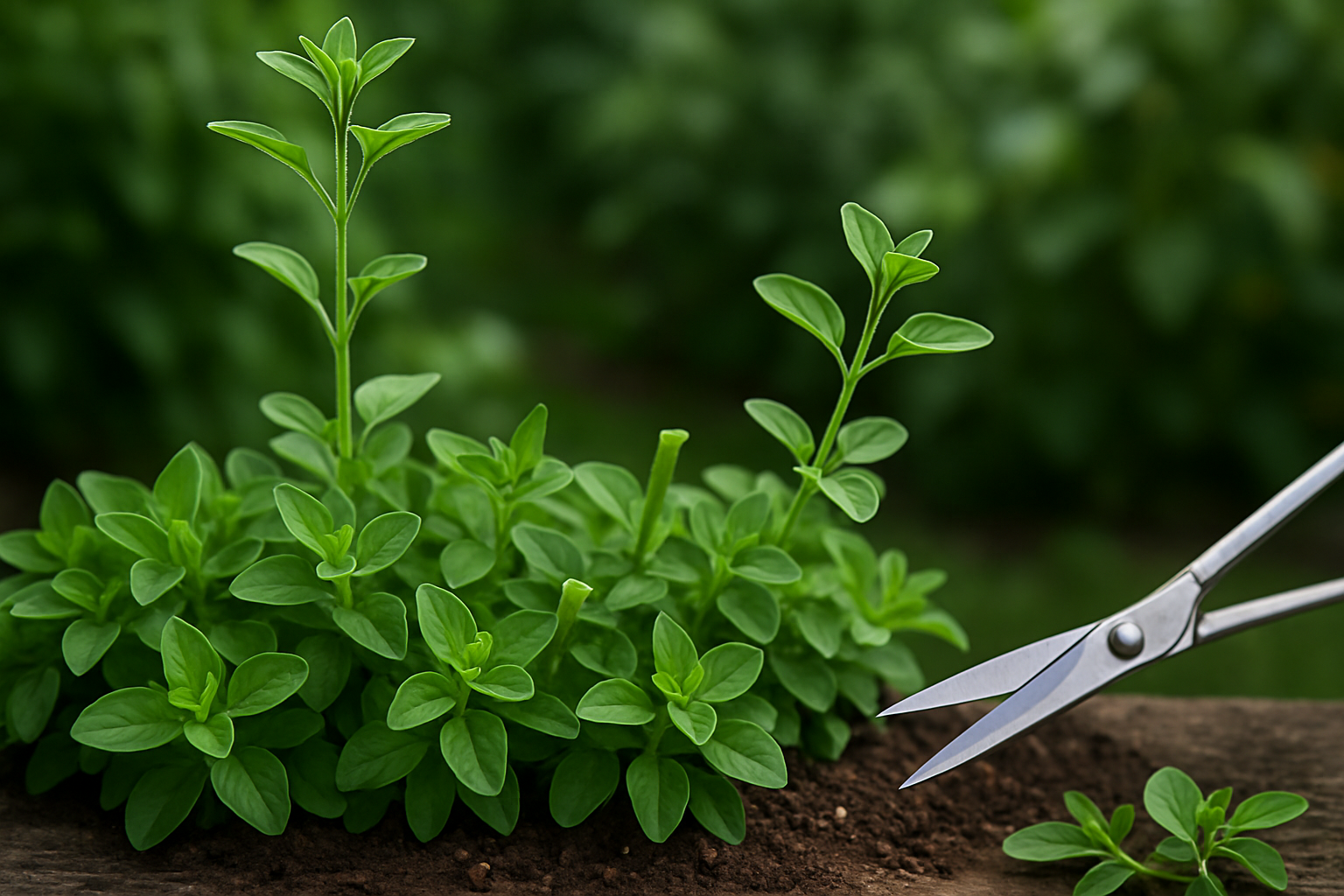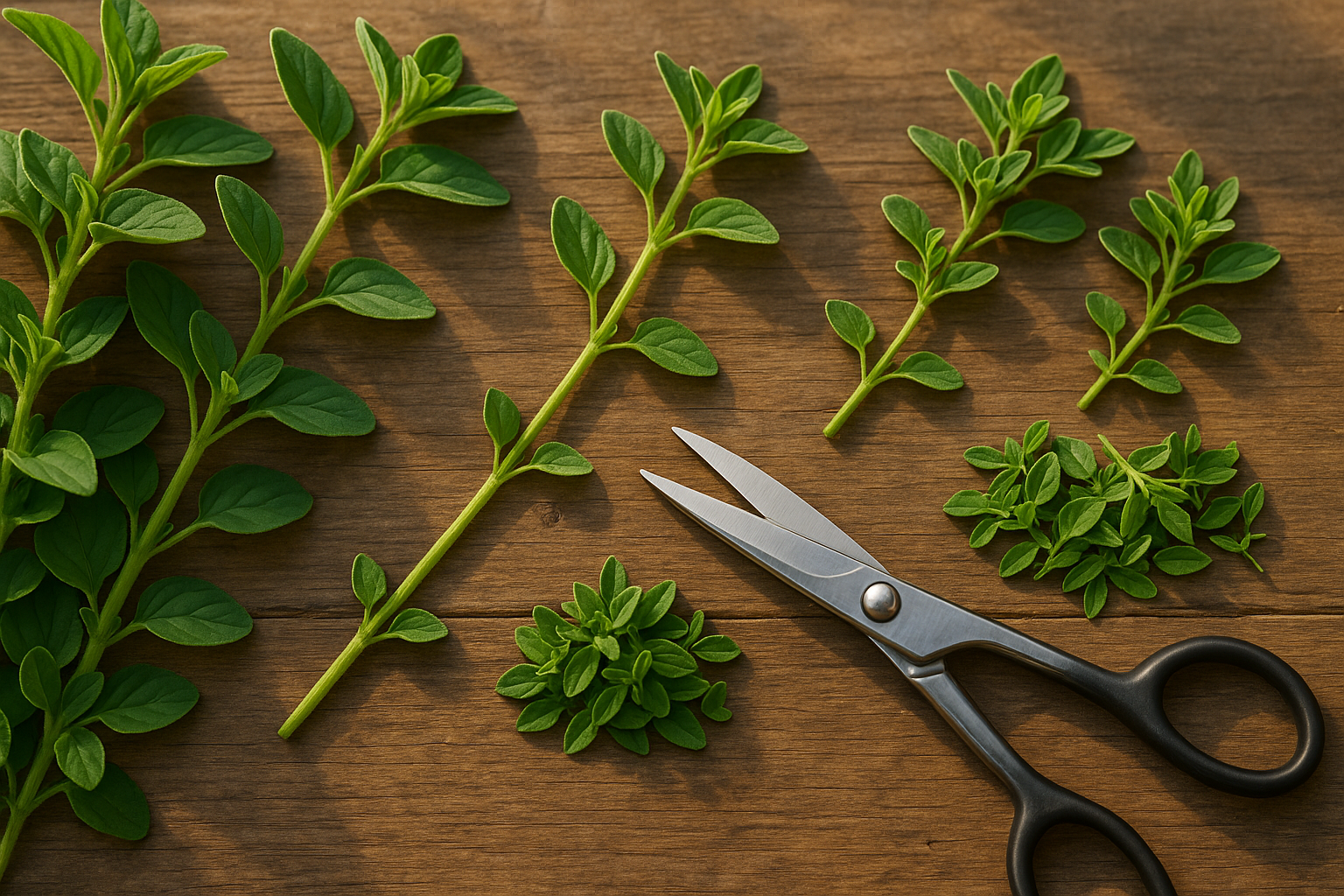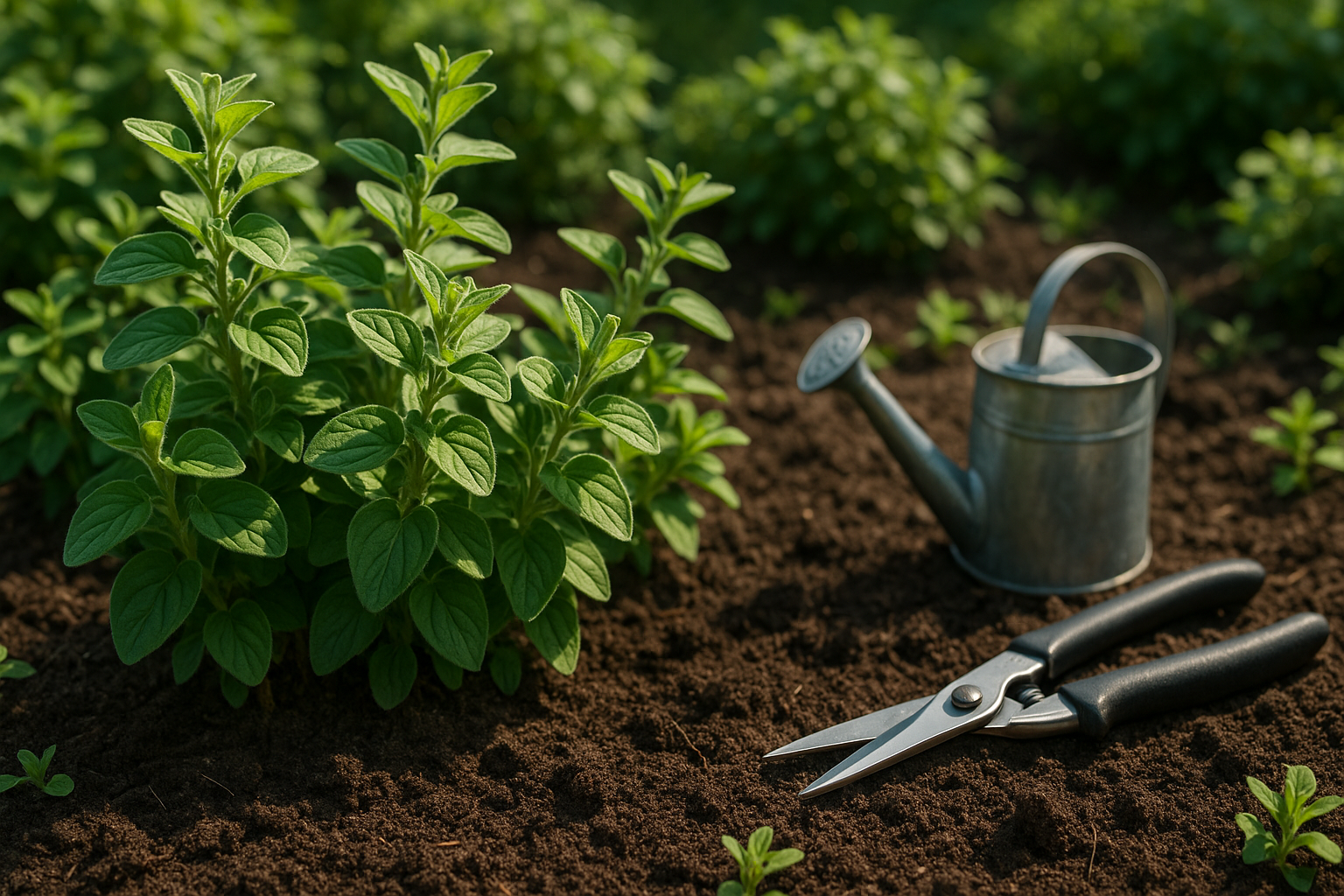Why Pruning Oregano Matters

Oregano is a staple in many kitchens, prized for its robust flavor and reliable productivity in everything from Italian sauces to homemade dressings. However, many gardeners mistakenly assume that oregano is a “plant-it-and-forget-it” herb that thrives without any attention. While oregano is indeed resilient and low-maintenance, regular pruning is key to getting the most out of your plants.
Pruning encourages oregano to grow bushier instead of tall and leggy. This not only produces a fuller and more attractive plant but also increases the number of leaves you can harvest. Every time you trim back stems, it signals the plant to send out new growth from below the cut, resulting in a denser, healthier mass of flavorful leaves.
Healthy, well-pruned oregano resists diseases and pests better because increased airflow around the plant helps prevent fungal issues that often plague dense or overgrown herbs. If you skip pruning, you may end up with woody stems and sparse foliage, reducing both your harvest and the herb’s flavor quality.
For the best results, start pinching back the tips when the plant reaches about four inches tall, and continue harvesting regularly throughout the growing season. Even just snipping off flower buds before they bloom can preserve leaf flavor and keep the plant productive.
So, while oregano will survive with minimal care, giving your plant a quick trim every few weeks ensures a healthier, bushier, and far more productive herb all season long.
When Is the Best Time to Prune Oregano?
Pruning oregano at the right times can make a big difference in the health and productivity of your plant. The best time for a major pruning is in early spring, just as fresh new growth begins. This encourages bushier plants and prevents older stems from becoming too woody.
Throughout the growing season, you can snip back stems every few weeks to harvest leaves and keep the plant from getting leggy. Simply cut above a set of healthy leaves to encourage side shoots. Watch for signs like stems stretching out or leaves looking sparse—this legginess means it’s time for a trim.
Before your oregano starts to flower, usually in mid-to-late summer outdoors, give it another pruning. Flowering reduces leaf flavor, so trimming at this stage keeps your harvest tasty and delays plant decline.
For outdoor oregano, pay attention to frost dates—prune in early spring and again before the autumn chill sets in. However, avoid heavy cutting right before winter. Indoor oregano can be pruned year-round since it’s not affected by outdoor temperature swings, but still follow the plant’s cues: when new shoots appear, the plant starts crowding its pot, or you notice declining vigor, give it a careful trim. Removing flower buds indoors also prolongs leaf production.
Whether inside or outside, always use sharp, clean scissors and remove up to a third of the plant at one time—more can shock oregano and slow regrowth. And remember, regular, gentle pruning isn’t just about appearance; it helps the herb stay healthy, flavorful, and full of life season after season.
How to Prune Oregano for Maximum Bushiness

Pruning oregano is simple, but a little technique goes a long way in encouraging your plant to grow bushier and more productive. Early in the season, when your oregano is still young and tender, focus on pinching back the top tips. Using your fingers or a pair of clean, sharp scissors, snip or pinch off about 1-2 inches from the very top of each stem, making your cut just above a pair of healthy leaves. This will signal the plant to branch out from the sides, resulting in a fuller shape.
As the season progresses and your oregano has put on more growth, you can move on to more substantial pruning around mid to late summer. Use clean, disinfected shears to trim stems back by up to one-third, always cutting just above a leaf node to encourage new shoots. Avoid cutting into the woody part of older stems, as these are slow to recover and may not regrow at all. Be sure not to remove more than a third of the plant at one time, as this can stress the oregano and slow its recovery.
Another key tip: always leave some healthy foliage on each stem to keep photosynthesis active and the plant vigorous. Regularly clean your tools before each use to prevent spreading disease—wipe them with rubbing alcohol or a bleach solution.
Don’t forget to watch out for the main central stems; cutting too low or into the thickest parts can damage the plant’s structure, so stick to snipping above active leaves. Light, regular pinching and selective, moderate pruning throughout the summer months keeps oregano lush, healthy, and bursting with flavor for your kitchen.
Pruning Different Oregano Varieties
Oregano comes in several popular varieties, each with its own growth pattern and pruning needs. Greek oregano, often considered the classic culinary choice, tends to be bushy and vigorous with soft stems. Regularly pinching back the growing tips every few weeks encourages it to branch out, resulting in a lush, productive plant.
Italian oregano, which is actually a marjoram hybrid, grows taller with a slightly less vigorous habit. Pruning should focus on removing flower buds as soon as they appear to keep the leaves flavorful.
Golden oregano is a ground cover with compact, trailing growth and golden-green foliage. It requires less frequent cutting but responds well to light trimming to maintain its dense shape.
When dealing with woody stems, often seen in older Greek or Italian oregano plants, prune back about one-third of the plant in early spring before new growth appears. Always cut just above a pair of healthy leaves to avoid stressing the plant.
For container-grown oregano, more frequent pruning is needed since limited root space can lead to faster leggy growth. Aim to harvest the stems regularly throughout the growing season, but never remove more than half the plant at one time.
In garden beds, oregano can tolerate heavier pruning and tends to recover quickly, especially with enough sun and good airflow.
Whatever the variety, make sure your shears are clean to prevent disease, and prune healthy, well-watered plants. This way, your oregano will remain vigorous, bushy, and packed with flavor all season long.
Caring for Oregano After Pruning
Right after pruning your oregano plant, it’s important to give it the right care to help it recover and thrive. Start by watering the plant thoroughly, but don’t overdo it—the soil should be moist but not soggy, as oregano dislikes sitting in water.
If you used sharp, clean shears, the cuts should heal quickly, but you can help by sprinkling a little compost or a balanced, slow-release fertilizer around the base to boost recovery.
Make sure your oregano remains in a sunny spot, as it needs at least 6 hours of direct light each day. If it’s in a pot, keep it near a bright window or on a sunny patio.
Within a week or two, you should notice tiny new leaves or shoots emerging near where you trimmed. To encourage bushier growth, pinch back the tips of any new stems once they reach about two inches long—this redirects energy and keeps the plant from getting leggy.
Throughout the next few weeks, keep a close eye on soil moisture, watering only when the top inch feels dry. Avoid heavy feeding, as oregano is a light feeder and too much fertilizer can stress it out more than help. Remove any yellowing or damaged leaves to prevent disease.
If you notice drooping or stunted regrowth, the plant may be shocked—ease up on watering, check for root rot, and avoid moving it until it bounces back.
With this attentive post-pruning care, your oregano should respond with vigorous, fragrant growth, ready for more harvests all season long.
What to Do with Pruned Oregano Stems
Freshly pruned oregano stems are little bundles of flavor just waiting to be put to good use. If you’re cooking, snip off the leaves and sprinkle them over pizzas, pastas, or roasted veggies for an instant flavor boost.
For future meals, try freezing the washed leaves in ice cube trays with olive oil—just pop out a cube whenever you want to add a burst of herby aroma to sauces or soups.
You can also dry the stems by tying small bundles and hanging them upside down in a cool, dry place for about a week. Once dry, crumble the leaves and store them in an airtight jar.
Oregano makes a comforting herbal infusion, too. Simply steep fresh or dried leaves in hot water for a few minutes to enjoy a fragrant tea that’s great for soothing a sore throat.
If you want more oregano in your garden, use the healthiest pruned stems as cuttings: snip off a section about 5 inches long, remove the lower leaves, and place the stem in a glass of water on a sunny windowsill. When roots form, transplant the cutting into soil and watch your oregano patch flourish.
With a dash of creativity, those pruned stems can keep on giving!
Troubleshooting Common Oregano Pruning Problems
After pruning oregano, it’s common to notice some minor issues that might worry you, but most are easy to fix with a little attention. If you see yellowing leaves soon after a trim, it could simply mean the plant is recovering or was pruned a bit too heavily. Make sure you’re not removing more than one-third of the plant at a time, and hold off on watering for a day or two to let the roots recover.
Slow regrowth is often caused by a lack of sunlight or nutrients. Try moving your oregano to a sunnier spot and consider feeding it a balanced, diluted liquid fertilizer.
Another common issue is stems becoming woody and tough, especially on older plants. To prevent this, prune a little more frequently during the growing season, always targeting the lush, green growth rather than the older, woody parts, which bounce back more slowly.
Keep an eye out for pests like aphids or fungal spots on the leaves after pruning—they love weakened plants. Spraying the leaves gently with water or neem oil can help. Also, always prune with clean, sharp scissors to avoid introducing disease.
Remember, oregano is a resilient herb that usually recovers well from most mishaps. Even if your plant looks sparse or scruffy after pruning, give it a couple of weeks—new, fragrant foliage will almost always emerge. If problems persist for more than a month, or if the plant starts wilting significantly, it’s a good idea to reassess light, water, and soil conditions.
Overall, most beginner gardeners find oregano to be quite forgiving.
Summary & Quick Tips for Thriving Oregano
Pruning oregano at the right time—usually in early spring or right after the first harvest—keeps the plant healthy and bushy. Use clean, sharp scissors to snip above a leaf node, and always remove no more than a third of the plant at once to avoid stress. After pruning, water lightly and consider adding a bit of organic fertilizer to support new growth.
Dos
- Prune regularly.
- Harvest often to encourage more leaves.
- Check for woody stems and cut them back for better airflow.
Don’ts
- Avoid overwatering.
- Don’t prune below the lowest leaves.
- Never remove all the foliage at once.
With these simple steps, even beginner gardeners can confidently prune oregano for a lush, productive herb patch. Trust your instincts and observe your plant’s response—it’s surprisingly forgiving if you follow this routine, and you’ll enjoy abundant, flavorful oregano in your kitchen all season.
